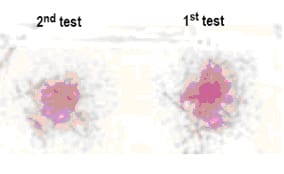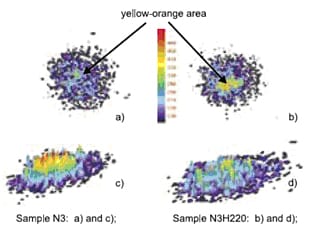Pressure Film can be defined as a tactile, pressure indicating sensor film that may be used to reveal the distribution and magnitude of pressure between any two contacting, mating, or impacting surfaces. Fujifilm Prescale® is the leading brand of Pressure Film.
Elzbieta Maklewska, Izabella Krucinska, and Gerard E. Mayers reported on the use of Fujifilm Prescale® Pressure Film in an article titled, “Estimating the Shock-Absorbing Ability of Protector Materials by Use of Pressure Films”. This article was published in FIBRES & TEXTILES in Eastern Europe, October/December 2005, Vol 13, No 4, pp 52–55.
Maklewska, et al, studied sports activities, such as horse riding, football, hockey, and motorcycling. These sports involve the risk of injuries from the effects of impacts. Special clothing for these sports contains protectors to dampen the energy of impacts. In their work, the researchers used Fujifilm Prescale® Pressure Film was to measure the impact energy on various protection materials. Figure 1 shows the impact test stand used for their tests.

Fig 1: Impact Test Stand: a) is the Fujifilm Prescale® Pressure Film, b) is the anvil, and c) is the protector sample being tested.
The Fujifilm Prescale® Pressure Film is a Mylar®-based film that contains a layer of tiny microcapsules. The application of force upon the film causes the microcapsules to rupture, producing an instantaneous and permanent high-resolution, topographical image of pressure variation across the contact area. Like Litmus paper, the color intensity of the film is directly related to the amount of pressure applied to it, the greater the pressure, the more intense the color. Figure 2 shows the imprints of two impacts on Fujifilm Prescale® Pressure Film.

Fig 2: Imprints of Two Impact Tests on Fujifilm Prescale® Pressure Film
Following the tests, the Pressure Film sheets were sent to Sensor Products for optical imaging and analysis using the Topaq® Pressure Analysis System. Topaq® revealed the areas of highest impact pressure as transmitted through the samples tested. A pseudo-coloring of the scanned 2D and 3D image showed, in the yellow-orange area, where the values of the impact force measured were greatest (Figure 3).

Fig 3: The 2D and 3D Rendering of the Data Recorded on the Fujifilm Prescale® Pressure Film
The results of the Topaq® analysis for the Drop Tower Impact Tests in Figure 3 are summarized in the table below.

In this study, a medium, Pressure Film with a pressure range of 1,400-7,100 psi (1-5 kPa) was used. Therefore, only pressures in that range were recorded. This fact may explain why the force values (FT) obtained in the Pressure Film tests are lower than the force values (FD) obtained from the drop tower measuring systems.
A key conclusion from the Maklewska, et al, paper is that the Fujifilm Prescale® Pressure Film permits researchers to determine the pressure and force distribution during impact with relative ease. This information can aid designers of impact protection to reduce the risk of injury during accidents.


